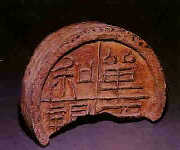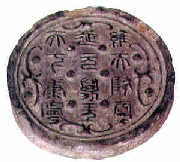In the old days, roof tiles were black tiles. During theTang Dynasty(618-907), the technique and materials of "Tang tricolor-glazed pottery" were adopted into roof tiling and wadang making, producing glazed tiles and wadangs known today as the world-famous "liu-l."
Distinctions between rich and poor people are apparent in the details. The color of the glazed wadangs, like the art of traditional roofs, represented the social status. There were many colorful figurine ornaments that were made in the image of animals and which were placed on ridges and roof edges of great houses, serving as guardians and protectors. However, common people could only use simple black tiles.
 An art of practicality and aesthetics
An art of practicality and aesthetics
 The design ofwadangsvaries greatly. In the ancient times, people began to carve a few characters or paintings on wadangs, in order to pray for fortunes and repel demons.
The design ofwadangsvaries greatly. In the ancient times, people began to carve a few characters or paintings on wadangs, in order to pray for fortunes and repel demons.
More than half of Guan's collections are Yan wadangs made during theWarring States Periodin the State of Yan, presently the areas ofBeijingandHebei Province(both in North China). The weather-beaten, heavy khaki tiles, seemingly of no particularity, are well preserved and seamlessly integrate with each other when layered together. The designs on them, with little erosion, are still legible after about three thousand years. A clear and melodious sound echoes when the wadangs are tapped int the middle, like a remote sound rising and falling from far away.
The pieces collected by Guan are incredibly opulent scenes ofcalligraphy, monsters, animals, and so on. The orderly arranged winding, ropelike characters stand out in relief and adapt themselves to fit within the confines of circular or semi-circular wadang forms. The various designs each bear a meaningful story of political, cultural and religious essence, with the chief purpose of producing an auspicious aura.
But most Yan wadangs in his collection involve designs of monsters with delicate differences in facial features, such as single or double eyelids, linear or diamond eyebrows, three-branched tongues, and noses with five nostrils. Sometimes the necks or tails of the two animals are entwined, which implicates mating and sex. The Ancients believed that wadangs carrying such designs helped to ward off evil spirits.
Some special wadangs were used on the eaves to fix other pieces of tiles and to prevent rain from falling into the house. Normally, these special wadangs were each as large as a bowl.
 Codes to understand puzzling historic facts
Codes to understand puzzling historic facts
 Wadangs a very special treasure in Chinese architectural history. As well as being an art that combinescalligraphy, painting, craftwork, and carving, the art of wadangs also is a result of the combination of practicality and aesthetics, adding much beauty to ancient architectures.
Wadangs a very special treasure in Chinese architectural history. As well as being an art that combinescalligraphy, painting, craftwork, and carving, the art of wadangs also is a result of the combination of practicality and aesthetics, adding much beauty to ancient architectures.
Guan's rich collections are more than just a showcase; they are historical material objects for his profound research on China's millenniums-old wadang culture.
Guan spent the past two years doing textual research on the paintings and characters on the surfaces of his wadangs, looking through dozens of reference documents likeZuo Zhuan(Zuo's Commentary on Spring and Autumn Annals, a famous historical book recording the history of theSpring and Autumn Periodfrom 770-476BC); Shi Ji (TheRecords of the Great Historian, the first general historical book in the form of series biographies in China); and Han Shu (History of the [Former] Han Dynasty, a biographic dynastic history of theWestern Han Dynastyfrom 206BC-8AD), and so on.
He analyzed altogether 268 wadang designs of the pre-Qin and Han dynasties, of which about three-fourth are new finds, and less than one-fourth are historical revisions, decoding some puzzling historic facts unexplained for millenniums.
In his A Textual Research on Pre-Qin and Han Wadang Decorations, Guan attached a short verse to each wadang illustration, commentating vividly and fondly on the historical significance of each piece. The book provides important data for the archeological study of ancient buildings and at the same time offers some reference for the study of politics, economics, and culture in different periods throughout China's history.
